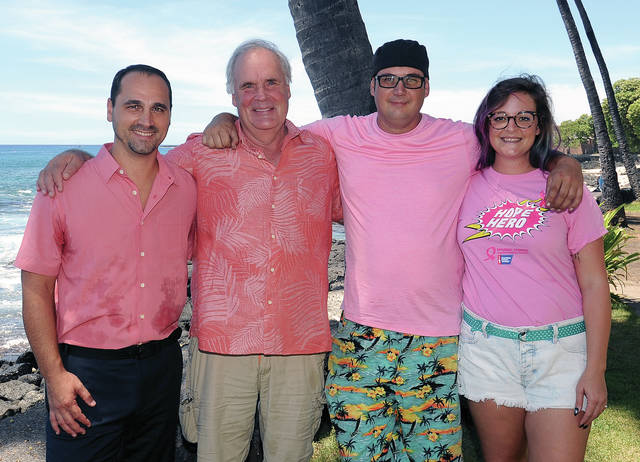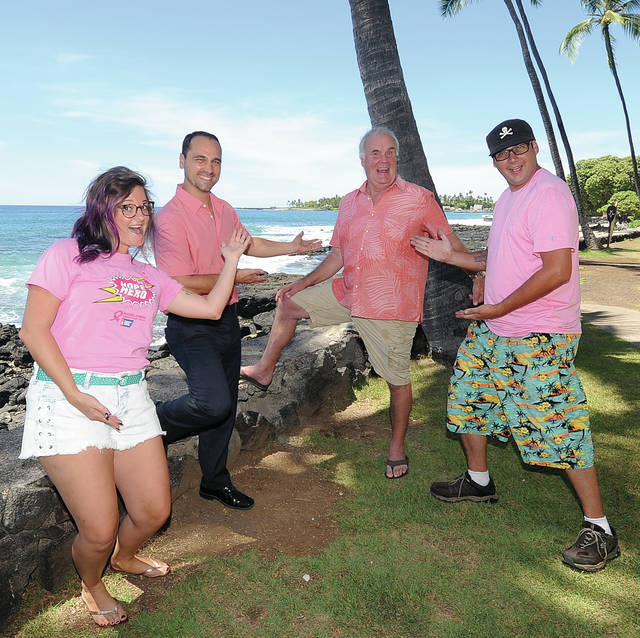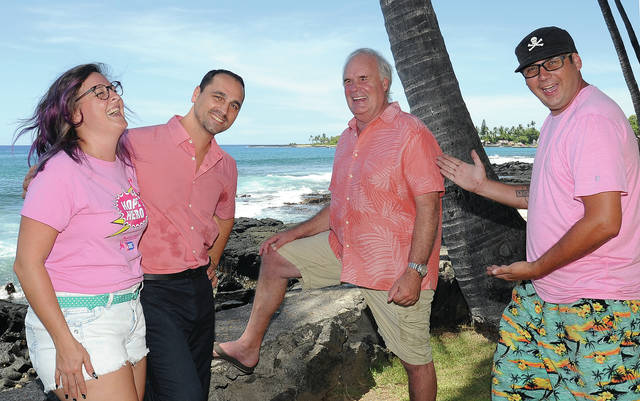Real Men Wear Pink campaign aims to raise money, inspire involvement for American Cancer Society


Kaitlin Moore, Caleb Milliken, Peter Schonburg and Nick Traxler ham it up for the Real Men Wear Pink of Kona Campaign. (Laura Ruminski/West Hawaii Today)

Kaitlin Moore, Caleb Milliken, Peter Schonburg and Nick Traxler ham it up for the Real Men Wear Pink of Kona Campaign. (Laura Ruminski/West Hawaii Today)
KAILUA-KONA — When it comes to the fight against breast cancer, awareness, said Nick Traxler, isn’t enough.
KAILUA-KONA — When it comes to the fight against breast cancer, awareness, said Nick Traxler, isn’t enough.
“People are aware breast cancer exists; we’re promoting involvement,” said Traxler, owner of Privateer’s Cove. “The more important thing is involvement. It’s the activity around it.”
And this month, Traxler, along with Peter Schonberg and Caleb Milliken, will be taking part in the Real Men Wear Pink campaign in Kona, an effort to not only raise awareness and money for American Cancer Society programs and research, but also encourage men in the community to get involved in the battle against breast cancer.
“We all know that the pink ribbon is breast cancer. It’s really well-known,” said Kaitlin Moore, community development manager for American Cancer Society, North and West Hawaii. “What the American Cancer Society wanted to do was to bring the men into it by giving them their own event.”
Nationwide, candidates taking part in the campaign pledge to wear something pink every day of the month of October, share the campaign on their social media pages and raise funds. The local candidates, Moore said, each have a fundraising goal of $2,500.
Moore said she’s set a total goal of $10,000 for the entire campaign in Kona.
The money, she said, will go toward research and programs like Hope Lodge, which offers cancer patients and their caregivers accommodation when away from home for treatment.
One Hope Lodge is located in Honolulu, and Moore said more than 63 percent of its residents come from Hawaii Island.
And each of the three men taking part in the local campaign have their own reasons for getting involved
“I personally have had a number of friends — dear friends — who have had breast cancer,” said Schonberg. “And some have recovered and done well, and some haven’t.”
Schonberg is also co-inventor of the CyberKnife System, used in cancer treatment.
Milliken, director of the West Hawaii Fatherhood Initiative under Family Support Hawaii, said while he doesn’t have a direct connection to cancer, his work supporting fathers has a real stake in supporting women as well.
“If we’ve got something in our society that is life-threatening to the other half of our population,” he said, “then it’s something that I take great interest in.”
Community members can donate through the campaign’s web page, available at https://bit.ly/2OaMlHz. Donors can contribute at that site by selecting their candidate of choice and clicking the “donate” button and filling out the form. Donations can also be sent via mail.
That site is also where community members can find details about upcoming fundraising events for the campaign under the “Upcoming events” tab on the website. That includes “Feast for a Cure,” scheduled for Oct. 14 at Privateer’s Cove. The fundraiser is $55 per person and reservations are required.
The campaign also marks an opportunity to stir people — men and women — to action.
That includes, Moore said, encouraging women to be more proactive in self-examination and identifying any abnormalities as well as speaking about their concerns with their doctors.
“You have to be your own self-advocate when it comes to your health care,” she said.
Schonberg said the effort to educate goes deeper than just awareness.
“It’s actually learning about what steps you can take and how you can approach things,” he said.
And, the candidates reiterated, the fight isn’t just for one half of the population, saying everyone has a responsibility to involve themselves.
“If you don’t get involved, guess what, the problem’s never going to sort itself out,” said Traxler.
And even for those who can’t give time or money, Milliken said, caring can also make a difference.
“Sometimes that’s all somebody can do,” he said, “but everybody can do that.”
Raising awareness is just that, he said: getting people to care.
“Because if they care, then they’ll get involved,” he said, “and then they’ll give their time, treasure and talent.”
And by being visible and stoking conversation among their social groups, the opportunities are endless.
“What I’m hoping is that if I’m out there, people either inside my circle or outside of my circle will talk to me about things,” Schonberg said, “and I think that kind of communication — who knows what’ll come out of it?”


